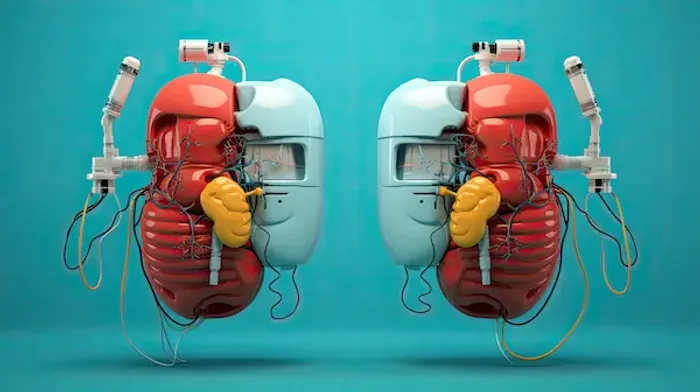Guide to Robot Assisted Kidney Transplant
Discover the benefits, procedure, and recovery of robot-assisted kidney transplants. Learn how minimally invasive robotic surgery improves safety, pain management, and recovery time.


Introduction
For anyone facing kidney failure, a transplant is a beacon of hope, offering a chance at a significantly improved quality of life. However, the thought of major open surgery can be daunting. Today, medical technology has ushered in a new era of precision and patient comfort with the robot-assisted kidney transplant. This advanced minimally invasive procedure is transforming the transplant experience, making it safer and less taxing for many patients. But what exactly does it involve, and how does it differ from traditional methods? This guide will demystify the process, breaking down the benefits, the step-by-step procedure, and what you can realistically expect during recovery. We'll explore how this cutting-edge approach, often using the da Vinci surgical system, allows surgeons to perform complex transplant surgery with enhanced vision and unmatched precision through just a few small incisions. Whether you are a potential recipient or a living donor considering your options, understanding the advantages of robotic kidney surgery is a crucial first step in your healthcare journey.
What is a Robot-Assisted Kidney Transplant?
A robot-assisted kidney transplant is a minimally invasive surgical procedure where a surgeon uses a robotic system to perform the delicate operation of placing a healthy donor kidney into a recipient. It's crucial to understand that the robot does not operate on its own. Instead, it is a sophisticated tool that translates the surgeon’s hand movements into smaller, more precise actions of tiny instruments inside the body.
Beyond Science Fiction: The Surgeon is Always in Control
The most common system used is the da Vinci surgical system. The surgeon sits at a console a few feet away from the patient, viewing a high-definition, 3D magnified image of the surgical site. Using master controls, the surgeon’s hand, wrist, and finger movements are filtered and scaled in real-time to guide the robotic arms. This technology eliminates hand tremors and allows for movement that is more flexible than the human wrist, which is vital when connecting tiny blood vessels and the ureter.
Robotic Transplant vs. Open Surgery: A Fundamental Difference
The key difference lies in the approach. In a traditional open kidney transplant, the surgeon makes a long incision (often 6-8 inches) in the lower abdomen to access the iliac artery and vein, where the new kidney will be connected. In contrast, a robotic-assisted transplant requires only a few small keyhole incisions, each about a centimetre long, through which the robotic arms and a camera are inserted. This minimally invasive approach is the source of its significant benefits, leading to less tissue damage and a fundamentally different recovery experience.
Consult a Specialist for the best advice
Top Benefits of Choosing a Robotic Kidney Transplant
The advantages of this advanced technique extend far beyond just smaller scars. The benefits impact the entire patient experience, from the operating room to long-term health.
Less Pain and Minimal Scarring
Because the procedure avoids a large muscle-cutting incision, patients experience significantly less postoperative pain. This reduces the reliance on strong opioid pain medications after surgery, which can have side effects like nausea and constipation. The cosmetic result is also superior, with a few small scars instead of one large one, which is an important consideration for many patients.
A Faster Road to Recovery
This is one of the most celebrated benefits. With less trauma to the body, recovery is accelerated. Patients who undergo a robotic kidney transplant often have a shorter hospital stay—sometimes as little as 2-4 days compared to 5-7 days for open surgery. They also typically return to normal daily activities and work much sooner. A 2021 study published in the Journal of Robotic Surgery found that robotic transplant recipients had significantly shorter hospital stays and lower pain scores.
A Significant Advantage for High-BMI Patients
For patients with a high body mass index (BMI), open transplant surgery can be challenging due to a thicker abdominal wall, which increases the risk of wound healing complications like infections and hernias. The robotic kidney surgery technique is particularly beneficial here. The precision of the robot allows surgeons to operate effectively without a large incision in a deep wound, drastically reducing the risk of these complications and making transplant a safer option for this patient group.
Are You a Candidate for Robotic Kidney Surgery?
Not every patient is an ideal candidate for a robot-assisted kidney transplant. Eligibility depends on several factors that
your transplant team will evaluate thoroughly. Generally, good candidates include:
- Patients receiving a kidney from a living donor (the procedure is most commonly performed in this setting).
- Individuals who have not had multiple major previous abdominal surgeries, as scar tissue can complicate the procedure.
- Patients with specific anatomical considerations that make the robotic approach favorable.
- As mentioned, individuals with a high BMI who may be at increased risk from open surgery.
The final decision is made by a multidisciplinary team of transplant surgeons, nephrologists, and anaesthesiologists.
They will consider your complete medical history, current health status, and anatomical factors to determine the safest
and most effective surgical approach for you. Consulting with a transplant specialist, such as those available through
Apollo24|7, can provide personalised insight into whether this advanced option is suitable for your specific situation.
The Robotic Kidney Transplant Procedure: A Step-by-Step Guide
Understanding the process can help alleviate anxiety. Here’s a breakdown of what happens during the surgery.
Step 1: Preparation and Anaesthesia
You will receive general anaesthesia, meaning you will be completely asleep and pain-free throughout the procedure.
Step 2: Making the Small Incisions
The surgeon makes 4-5 small incisions (about 1 cm each) in your lower abdomen. These ports allow access for the robotic arms and the high-definition camera.
Step 3: The Surgical Team at Work
While the surgeon controls the robot from the console, the assisting surgeons and nurses are at your bedside, helping with instrument changes and monitoring the procedure.
Step 4: Connecting the New Kidney
The donor kidney is prepared and then introduced into the abdominal cavity through a slightly enlarged incision. Using the robotic instruments, the surgeon meticulously connects the renal artery and vein of the new kidney to your iliac artery and vein. Then, the ureter (the tube that carries urine from the kidney) is connected to your bladder. This vascular connection is where the robot’s precision is invaluable.
Step 5: Closing the Incisions
Once the new kidney is successfully connected and confirmed to be working (often by producing urine immediately), the robotic instruments are removed, and the small incisions are closed with sutures or surgical glue.
What to Expect During Recovery
The Hospital Stay
You will likely wake up with considerably less pain than with open surgery. You’ll be encouraged to sit up and walk within a day, which is crucial for preventing blood clots and speeding up recovery. The healthcare team will closely monitor your new kidney's function through blood tests. Your hospital stay for a robotic kidney transplant is typically shorter.
Returning Home and Long-Term Health
After discharge, you’ll receive detailed instructions on caring for your incisions, managing pain with milder medications, and avoiding strenuous activities for a few weeks. The most critical aspect of long-term success is adhering to your regimen of immunosuppressive medications to prevent rejection. You will have frequent follow-up appointments to monitor your kidney function and overall health. Apollo24|7 offers convenient home collection for essential post-transplant tests like creatinine levels, making it easier to stay on top of your health monitoring.
Potential Risks and How They Are Managed
While minimally invasive, a robot-assisted kidney transplant is still major surgery and carries risks, including bleeding, infection, blood clots, and the standard risks associated with transplantation, such as rejection of the new organ or complications from immunosuppression. The robotic approach may have specific risks, like conversion to open surgery if technical difficulties arise. However, experienced surgical teams at high-volume centers have protocols to manage these risks effectively. The proven benefits of reduced wound complications and faster recovery often outweigh the risks for appropriately selected patients.
Conclusion
The advent of robot-assisted kidney transplant represents a significant leap forward in patient-centered surgical care. By minimising the physical trauma of surgery, this innovative technique directly addresses some of the most challenging aspects of the transplant journey: pain, recovery time, and surgical risk, especially for vulnerable populations. While the technology is sophisticated, the goal is simple—to provide a safer, less painful, and more efficient path to receiving a life-changing kidney. If you or a loved one is considering a transplant, it is essential to seek information from a reputable transplant center that offers a full range of options, including robotic surgery. Having an informed discussion with your healthcare team about the best approach for your individual needs is the most important step you can take. For expert guidance, you can consult with a specialist surgeon online via Apollo24|7 to discuss your eligibility and the potential benefits of this advanced procedure.
Consult a Specialist for the best advice
Consult a Specialist for the best advice
Dr Ch Sashidhar
Nephrologist
20 Years • MBBS, MD General Medicine, DNB, Nephrology
Secunderabad
Apollo Hospitals Secunderabad, Secunderabad

Dr Praveen Kumar Etta
Nephrologist
10 Years • MBBS,MD DM(SGPGI) FORMER ASST(PIMS)
Hyderabad
Apollo Spectra Ameerpet, Hyderabad

Dr. Pardha Saradhi
Nephrologist
9 Years • MBBS, MD-DNB (Gen. Med.), DNB (Nephro)
Hyderabad
Apollo Hospitals D R D O kanchanbagh, Hyderabad
(75+ Patients)

Dr. Manju Kamal
Nephrologist
12 Years • MBBS,MD(General Medicine), DNB,DM(Nephrology)
Angamaly
Apollo Hospitals Karukutty, Angamaly

Dr. Aswini Kumar Panigrahi
Nephrologist
23 Years • MBBS, MD (Int. Med.), DNB Nephro
Hyderabad
Apollo Hospitals Jubilee Hills, Hyderabad
(200+ Patients)
Consult a Specialist for the best advice
Dr Ch Sashidhar
Nephrologist
20 Years • MBBS, MD General Medicine, DNB, Nephrology
Secunderabad
Apollo Hospitals Secunderabad, Secunderabad

Dr Praveen Kumar Etta
Nephrologist
10 Years • MBBS,MD DM(SGPGI) FORMER ASST(PIMS)
Hyderabad
Apollo Spectra Ameerpet, Hyderabad

Dr. Pardha Saradhi
Nephrologist
9 Years • MBBS, MD-DNB (Gen. Med.), DNB (Nephro)
Hyderabad
Apollo Hospitals D R D O kanchanbagh, Hyderabad
(75+ Patients)

Dr. Manju Kamal
Nephrologist
12 Years • MBBS,MD(General Medicine), DNB,DM(Nephrology)
Angamaly
Apollo Hospitals Karukutty, Angamaly

Dr. Aswini Kumar Panigrahi
Nephrologist
23 Years • MBBS, MD (Int. Med.), DNB Nephro
Hyderabad
Apollo Hospitals Jubilee Hills, Hyderabad
(200+ Patients)
More articles from Kidney Disease
Frequently Asked Questions
1. Is a robotic kidney transplant as safe as an open transplant?
Yes, when performed by an experienced surgical team at an accredited center, studies have shown that robotic kidney transplant has comparable safety and long-term success rates to open surgery, with the added benefits of being minimally invasive.
2. How long does the robotic surgery take?
The procedure typically takes between 3 to 4 hours, which is similar to or slightly longer than an open transplant. The extra time is offset by the significant benefits in recovery.
3. What is the success rate of a robotic kidney transplant?
The success rate is very high, with one-year kidney survival rates exceeding 95% at experienced centers, which is comparable to open transplantation. Long-term success depends on medication adherence and follow-up care.
4. Does insurance cover the cost of a robotic transplant?
Most major insurance providers cover robotic kidney transplant as it is a recognised and effective surgical technique. However, coverage can vary, so it's important to check with your specific insurance provider and the hospital's financial department.
5. Can the robot be used for living kidney donors (donor nephrectomy)?
Absolutely. Robotic surgery is also widely used for minimally invasive donor nephrectomy, allowing living donors to benefit from the same advantages of less pain and faster recovery, making the act of donation an easier experience




